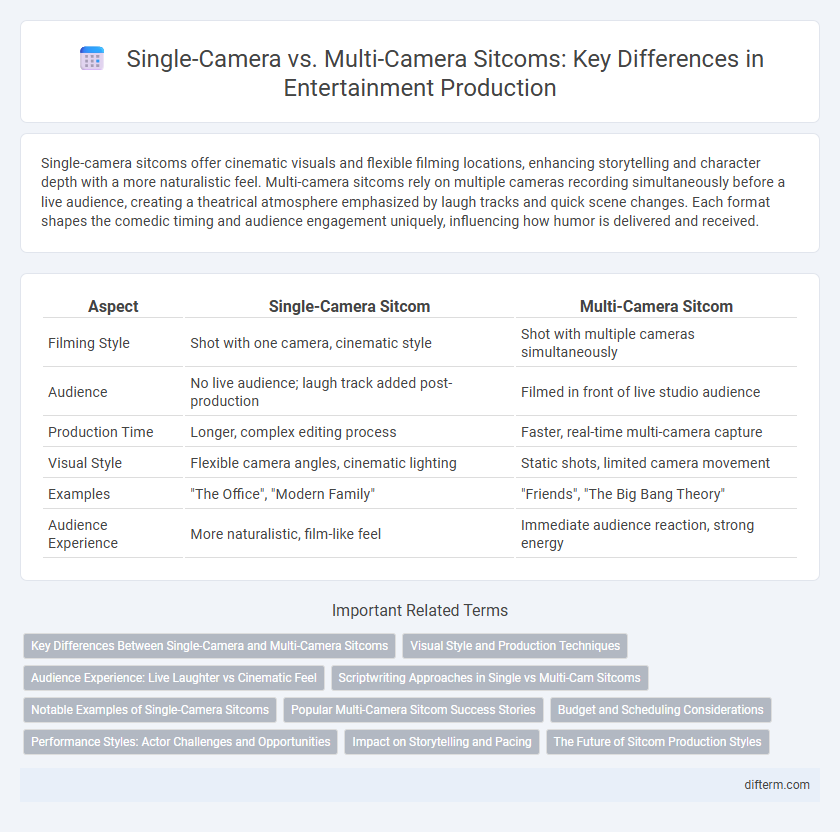Single-camera sitcoms offer cinematic visuals and flexible filming locations, enhancing storytelling and character depth with a more naturalistic feel. Multi-camera sitcoms rely on multiple cameras recording simultaneously before a live audience, creating a theatrical atmosphere emphasized by laugh tracks and quick scene changes. Each format shapes the comedic timing and audience engagement uniquely, influencing how humor is delivered and received.
Table of Comparison
| Aspect | Single-Camera Sitcom | Multi-Camera Sitcom |
|---|---|---|
| Filming Style | Shot with one camera, cinematic style | Shot with multiple cameras simultaneously |
| Audience | No live audience; laugh track added post-production | Filmed in front of live studio audience |
| Production Time | Longer, complex editing process | Faster, real-time multi-camera capture |
| Visual Style | Flexible camera angles, cinematic lighting | Static shots, limited camera movement |
| Examples | "The Office", "Modern Family" | "Friends", "The Big Bang Theory" |
| Audience Experience | More naturalistic, film-like feel | Immediate audience reaction, strong energy |
Key Differences Between Single-Camera and Multi-Camera Sitcoms
Single-camera sitcoms utilize one camera to capture scenes with greater cinematic flexibility, allowing for varied locations and dynamic shot compositions, often resulting in a more film-like aesthetic. Multi-camera sitcoms are shot simultaneously from multiple angles on a soundstage, enabling live audience reactions and faster production times, commonly seen in traditional comedy series. The key differences lie in production style, pacing, audience engagement, and overall visual presentation, which significantly impact comedic timing and storytelling approaches.
Visual Style and Production Techniques
Single-camera sitcoms utilize a cinematic visual style with varied shot compositions and locations, creating a more dynamic and polished aesthetic. Multi-camera sitcoms rely on fixed camera setups in front of live audiences, producing a theater-like atmosphere with consistent lighting and minimal scene changes. Production techniques for single-camera shows involve extensive editing and post-production, whereas multi-camera sitcoms emphasize real-time performance and faster shooting schedules.
Audience Experience: Live Laughter vs Cinematic Feel
Single-camera sitcoms deliver a cinematic feel with dynamic camera angles and film-like production, enhancing visual storytelling and emotional depth. Multi-camera sitcoms capture live laughter and audience reactions, creating an interactive, theater-like experience that heightens comedic timing. The choice between formats shapes viewer engagement, with single-camera shows offering immersion and multi-camera shows fostering a communal atmosphere.
Scriptwriting Approaches in Single vs Multi-Cam Sitcoms
Single-camera sitcoms employ a cinematic scriptwriting approach with naturalistic dialogue and subtle character development, allowing for more nuanced storytelling and varied scene settings. Multi-camera sitcoms rely on punchline-driven scripts structured around live audience reactions, emphasizing rapid-fire jokes and repetitive setups to maximize comedic timing. Writers of single-camera formats craft layered narratives with greater visual detail, whereas multi-camera scripts focus on pace and rhythm to engage viewers instantly.
Notable Examples of Single-Camera Sitcoms
Single-camera sitcoms like *The Office*, *Arrested Development*, and *Parks and Recreation* utilize cinematic techniques, offering a more dynamic and flexible storytelling style compared to multi-camera sitcoms. These shows often feature location shoots and lack a live studio audience, enhancing their ability to create immersive, character-driven narratives. The single-camera format supports a more naturalistic approach, which has been favored by critically acclaimed, innovative comedies in recent years.
Popular Multi-Camera Sitcom Success Stories
Popular multi-camera sitcoms like "Friends," "The Big Bang Theory," and "How I Met Your Mother" have achieved tremendous success by capturing live studio audience reactions, enhancing comedic timing and viewer engagement. These shows utilize multiple cameras to film episodes quickly and efficiently, allowing for dynamic scene coverage and consistent audience laughter. The multi-camera format supports ensemble casts and fast-paced dialogue, contributing to the longevity and widespread appeal of these sitcoms.
Budget and Scheduling Considerations
Single-camera sitcoms typically require higher budgets due to longer shooting times, elaborate setups, and location versatility, demanding more resources for lighting and sound. Multi-camera sitcoms benefit from lower production costs by filming on a single set with multiple cameras simultaneously, accelerating shooting schedules and minimizing post-production expenses. Scheduling on multi-camera shows is streamlined, often recording episodes in front of live audiences, while single-camera productions involve complex scheduling due to varied locations and scenes.
Performance Styles: Actor Challenges and Opportunities
Single-camera sitcoms demand actors to perform with naturalistic subtlety, often shooting scenes out of sequence, which challenges consistency in emotional delivery and timing. Multi-camera sitcoms require heightened energy and precision, with actors performing in real-time before a live audience, enhancing comedic timing through immediate feedback. This format fosters strong ensemble dynamics but limits opportunities for nuanced performances compared to the focused, cinematic approach of single-camera productions.
Impact on Storytelling and Pacing
Single-camera sitcoms offer greater flexibility in storytelling with cinematic techniques like varied shot compositions and location changes, enhancing emotional depth and narrative complexity. Multi-camera sitcoms rely on fixed sets and live audience reactions, which create a faster pacing and emphasize punchline-driven humor through timing and rhythm. The differences in production style directly affect character development, scene transitions, and comedic delivery, shaping the audience's engagement and overall story experience.
The Future of Sitcom Production Styles
Single-camera sitcoms offer greater creative flexibility and cinematic quality, making them increasingly popular as streaming platforms demand diverse content styles. Multi-camera sitcoms, traditionally filmed before live audiences, maintain strong appeal for their comedic timing and viewer engagement but face challenges adapting to modern production trends. Emerging technologies like virtual sets and advanced editing tools are likely to blend these styles, shaping the future of sitcom production with hybrid formats that balance authenticity and innovation.
Single-camera sitcom vs Multi-camera sitcom Infographic

 difterm.com
difterm.com